Notice the discarded leg on the petal below. George does a good job, but he's a bit sloppy at the table.
Friday, November 26, 2010
Pest control: Meet "George"
Notice the discarded leg on the petal below. George does a good job, but he's a bit sloppy at the table.
Saturday, November 20, 2010
In Bloom: A Study of Dendrobium bowmanii


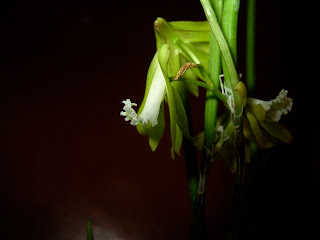
 These are Dendrobium bowmanii, synonym mortii, synonym Dockrillia bowmanii. I have five of these and four are currently in bloom. As you can see in the photos, they grow on long, spindly stems with needle-like leaves perhaps 3 inches long and very narrow, flowering from the nodes at the base of the fleshy leaves like other Dockrillas. Notice also the flowers are held up-side-down, another Dockrilla trait. The flowers are vaguely fragrant with a minty odor, matching nicely with their yellow-green color, and last about 2-3 weeks.
These are Dendrobium bowmanii, synonym mortii, synonym Dockrillia bowmanii. I have five of these and four are currently in bloom. As you can see in the photos, they grow on long, spindly stems with needle-like leaves perhaps 3 inches long and very narrow, flowering from the nodes at the base of the fleshy leaves like other Dockrillas. Notice also the flowers are held up-side-down, another Dockrilla trait. The flowers are vaguely fragrant with a minty odor, matching nicely with their yellow-green color, and last about 2-3 weeks.According to IOSPE, the species is native to mangrove swamps in Australia, and prefers warm to hot temperatures year round with a slightly drier winter rest.
I also have a Dendrobium rigidum blooming right now. I think I'll go off and introduce them to each other to see if we can't get something interesting...
Labels:
dendrobiums,
in bloom
Tuesday, November 9, 2010
In Bloom: Random Orange Stuff
It's Autumn, and we here on the East coast have been enjoying the fall foliage. It is ephemeral, fleeting, beautiful but ever-changing and far too temporary. But believe it or not, with the waning of Autumn color marks an increase in the number of blooming activity at our house, especially orchids, but I've got some other things as well. In honor of Autumn color, here are a few orange selections.
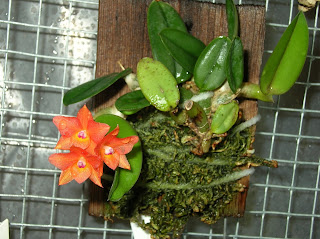 Sophronitis cernua blooming out of season. Supposedly they are Spring bloomers, but this is not the first time I've seen one have other ideas. This species is native to Southeastern Brazil, in warmer and brighter locations than you would typically find the other Sophronitis species. Hence, this one may grow for people that have had trouble with its cool and shady -growing relatives.
Sophronitis cernua blooming out of season. Supposedly they are Spring bloomers, but this is not the first time I've seen one have other ideas. This species is native to Southeastern Brazil, in warmer and brighter locations than you would typically find the other Sophronitis species. Hence, this one may grow for people that have had trouble with its cool and shady -growing relatives.
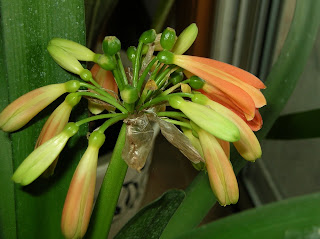 This is Clivia x Crytanthiflora, a naturally-occurring hybrid between two species miniata and nobilis. I've shown you this plant before, but I rather like her so you get to see her again. I did a major repotting of most of my clivias (it was kind of like, "when did I get SO MANY!?") this summer, and attempted to repot this one. Note: "Attempted." I couldn't get it out of the pot. When happy, Clivias have a rather aggressive root system consisting of thick, succulent, tentacle-like structures, a style which is consistent with certain other plants of South African origin, such as Strelitzias, and bearing some similarity to the structure of certain beefy orchid roots. I had two options with this plant: Break it out of the pot or leave it be. I wasn't in the frame of mind to crack open a very thick clay pot, and if the root system was that dense I wasn't sure I had an appropriately sized pot for it to go into, so I took option B.
This is Clivia x Crytanthiflora, a naturally-occurring hybrid between two species miniata and nobilis. I've shown you this plant before, but I rather like her so you get to see her again. I did a major repotting of most of my clivias (it was kind of like, "when did I get SO MANY!?") this summer, and attempted to repot this one. Note: "Attempted." I couldn't get it out of the pot. When happy, Clivias have a rather aggressive root system consisting of thick, succulent, tentacle-like structures, a style which is consistent with certain other plants of South African origin, such as Strelitzias, and bearing some similarity to the structure of certain beefy orchid roots. I had two options with this plant: Break it out of the pot or leave it be. I wasn't in the frame of mind to crack open a very thick clay pot, and if the root system was that dense I wasn't sure I had an appropriately sized pot for it to go into, so I took option B.
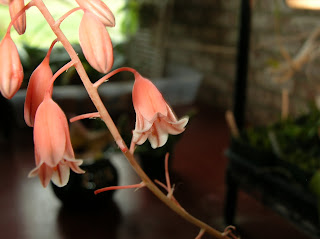
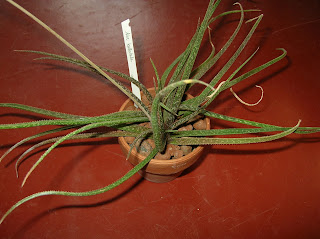 I love aloes, especially the little ones with cool leaves, but this is perhaps my favorite. This is Aloe bellatula. That is a 3 inch clay pot. I divided this plant this spring, selling one division, and keeping this one and one other. I had fully intended to sell another division, but they're just SO CUTE. Give me time, I'll either produce more divisions or will finally reconcile giving up my extra. Its like meeting a litter of kittens...I just want to keep them all. Anyway, its easy to grow and a reliable bloomer, though not as prolific a bloomer as some of the little Aloes, it does bloom at least once every year with these adorable bell-shaped orange-peach flowers. I'm not terribly knowledgeable on succulents, but I'll tell you what works for me. I keep the plant with my intermediate-growing cattleyas, meaning it lives in my unheated basement during the Winter and gets watered a lot less than during the Summer, but does still get watered a least a little bit every 2-3 weeks. In summer it gets watered every 2-3 days, especially when it is very hot and sunny.
I love aloes, especially the little ones with cool leaves, but this is perhaps my favorite. This is Aloe bellatula. That is a 3 inch clay pot. I divided this plant this spring, selling one division, and keeping this one and one other. I had fully intended to sell another division, but they're just SO CUTE. Give me time, I'll either produce more divisions or will finally reconcile giving up my extra. Its like meeting a litter of kittens...I just want to keep them all. Anyway, its easy to grow and a reliable bloomer, though not as prolific a bloomer as some of the little Aloes, it does bloom at least once every year with these adorable bell-shaped orange-peach flowers. I'm not terribly knowledgeable on succulents, but I'll tell you what works for me. I keep the plant with my intermediate-growing cattleyas, meaning it lives in my unheated basement during the Winter and gets watered a lot less than during the Summer, but does still get watered a least a little bit every 2-3 weeks. In summer it gets watered every 2-3 days, especially when it is very hot and sunny.
Monday, November 8, 2010
How I got started
The following is my entry for participation in the EtsyCREST Blog Carnival, Nov 2010. The prompt is, "How did you get started in your art/craft?"
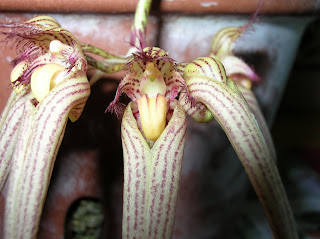 As many of you are already aware, I'm involved in a variety of endeavors, but my main thing is still plants, primarily orchids. I've been interested in horticulture since I was a kid, dazzled by my Granddad's enormous houseplants and extensive vegetable garden. I grew a number of things, and still have a few of the Dracaenas I got back then as wee cuttings. They're shrubs now. By the way, if you have one of these and it doesn't do much for you, try moving it (gradually) to a very bright South-facing window. These things are trees in the wild.
As many of you are already aware, I'm involved in a variety of endeavors, but my main thing is still plants, primarily orchids. I've been interested in horticulture since I was a kid, dazzled by my Granddad's enormous houseplants and extensive vegetable garden. I grew a number of things, and still have a few of the Dracaenas I got back then as wee cuttings. They're shrubs now. By the way, if you have one of these and it doesn't do much for you, try moving it (gradually) to a very bright South-facing window. These things are trees in the wild.
But I digress. I would page through and read generic houseplant books, making lists of things I'd like to try. Orchids seemed the gold standard. They have that reputation of being a challenge, but the promise of spectacular success is unrivaled - large, long lasting flowers in a variety of shapes and colors. Little did I know just how much variety.
I received my first orchid as a gift, which died a spectacular death of rot as a result of bad advice. As a plant enthusiast, I had to try again, this time armed with better resources. As luck improved, so did the desire for more plants and information, as is so often the case. While in college, I joined AOS and began attending NCOS meetings, and you could often find me on the weekends at Arbec Orchids. Working at Arbec resulted in an exponential increase in orchid-growing experience and trivia, including some tutelage from Roger Cole in orchid breeding techniques and lore.
Arbec has since moved and become a smaller business selling only at markets and shows, but some of you will still see evidence of it in my plants as I still have a couple rolls of the outdated Arbec plant tags... I really should get my own.
My research projects in college and for several years after focused on plant gene expression, providing handy access to laboratories with quality equipment and the experience for sterile culture. Given that I always enjoyed growing things from seed, the next logical step then seemed to try growing orchids from seed.
These days I have moved on to work on bacterial pathogens, but the clandestine Friday night use of the labs for orchid seed sowing is simply accepted as one of my quirks. My house is crammed with plants, and these days, flasks and young seedlings.
Are you looking to get started with orchids? Here's some orchid culture articles to get you started, and always feel free to drop me a line through Etsy or by email!
See how my other teammates got started:
The Dragon Nthly
raine studios
Birch Tree Jewelry
Twisted Cow
CT2 Designs
Sandi Volpe
Sew Artsy Amy
Purple Clover Art
Fripperie
Turquoise Angels
Of Cats and Crafts
But I digress. I would page through and read generic houseplant books, making lists of things I'd like to try. Orchids seemed the gold standard. They have that reputation of being a challenge, but the promise of spectacular success is unrivaled - large, long lasting flowers in a variety of shapes and colors. Little did I know just how much variety.
I received my first orchid as a gift, which died a spectacular death of rot as a result of bad advice. As a plant enthusiast, I had to try again, this time armed with better resources. As luck improved, so did the desire for more plants and information, as is so often the case. While in college, I joined AOS and began attending NCOS meetings, and you could often find me on the weekends at Arbec Orchids. Working at Arbec resulted in an exponential increase in orchid-growing experience and trivia, including some tutelage from Roger Cole in orchid breeding techniques and lore.
Arbec has since moved and become a smaller business selling only at markets and shows, but some of you will still see evidence of it in my plants as I still have a couple rolls of the outdated Arbec plant tags... I really should get my own.
My research projects in college and for several years after focused on plant gene expression, providing handy access to laboratories with quality equipment and the experience for sterile culture. Given that I always enjoyed growing things from seed, the next logical step then seemed to try growing orchids from seed.
These days I have moved on to work on bacterial pathogens, but the clandestine Friday night use of the labs for orchid seed sowing is simply accepted as one of my quirks. My house is crammed with plants, and these days, flasks and young seedlings.
Are you looking to get started with orchids? Here's some orchid culture articles to get you started, and always feel free to drop me a line through Etsy or by email!
See how my other teammates got started:
The Dragon Nthly
raine studios
Birch Tree Jewelry
Twisted Cow
CT2 Designs
Sandi Volpe
Sew Artsy Amy
Purple Clover Art
Fripperie
Turquoise Angels
Of Cats and Crafts
Labels:
Blog Carnival,
orchids,
plants
Sunday, November 7, 2010
The Rabbit Disaster of 2010
I was away a couple days, and I came home to mass destruction. Example below.
Note to self: Do not keep rabbits and orchids on same floor of house.
I suppose in retrospect I should have suspected she was not the angelic fuzz-producer she passed herself off as. I did, after all, witness this chummy water-cooler discussion between her and the local daemons.
Labels:
amigurumi,
assorted cats and pets,
cattleyas
Subscribe to:
Posts (Atom)
